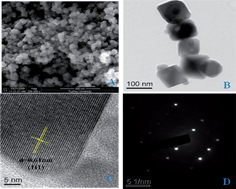Dual-channel cathodic electrochemiluminescence of luminol induced by injection of hot electrons on a niobate semiconductor modified electrode
Abstract
In this paper, a new niobate semiconductor photocatalyst Sr0.4H1.2Nb2O6·H2O (HSN) nanoparticle was applied to investigate the cathodic electrochemiluminescent (ECL) behavior of luminol for the first time. The results presented here demonstrated that there were two ECL peaks of luminol at the cathodic potential attributed to immobilization of HSN on the electrode surface. It is implied that HSN can be electrically excited and injected electrons into aqueous electrolytes from this electrode under a quite low potential that only excites luminol. A mechanism for this luminol-ECL system on HSN/GCE has been proposed. Additionally, this HSN/GCE has lots of advantages, such as high stability, good anti-interference ability, simple instrumentation, rapid procedure and ultrasensitive ECL response. It is envisioned that this HSN/GCE has further applications in biosensors.


 Please wait while we load your content...
Please wait while we load your content...